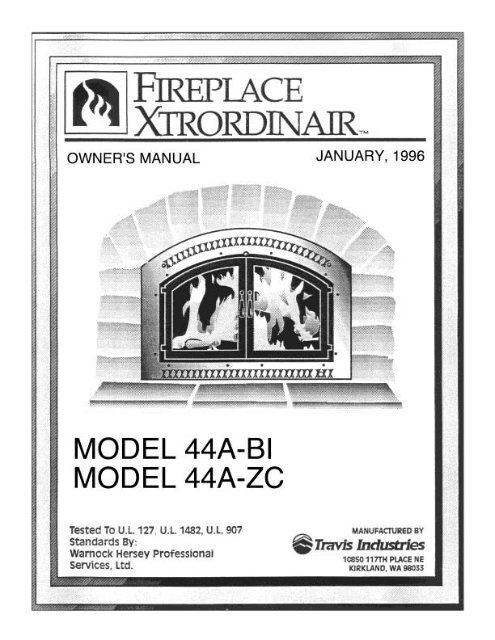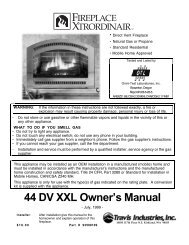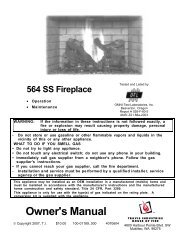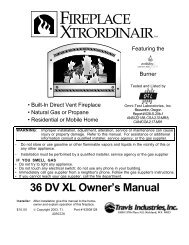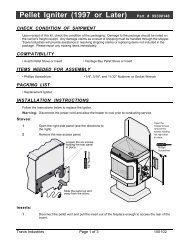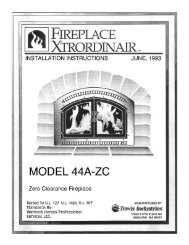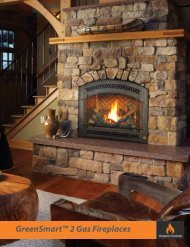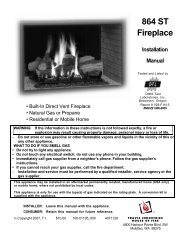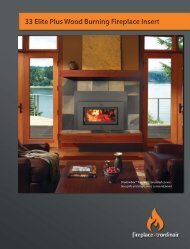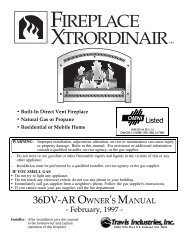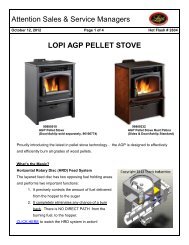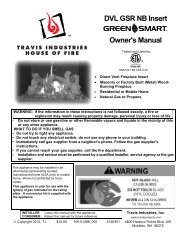44A ZC - Travis Industries Dealer Services Login Page
44A ZC - Travis Industries Dealer Services Login Page
44A ZC - Travis Industries Dealer Services Login Page
You also want an ePaper? Increase the reach of your titles
YUMPU automatically turns print PDFs into web optimized ePapers that Google loves.
OPERATING YOUR APPLIANCELocation and Use of ControlsNOTE:The Combustion Air Control and Combustor By-Pass Control become hotduring operation. Use a glove to adjust these controls while the appliance ishot.Combustion Air ControlThe Combustion Air Control is located in the center over the door and is operated by sliding itfrom left to right. When the control is completely to the left, it is in the fully open position.When it is completely to the right, it is in the fully closed position.Combustor By-Pass ControlThe Combustor By-Pass Control is located on the upper right of the appliance and isoperated by pushing or pulling the control. When pulled out all the way, the catalyticcombustor is bypassed.Blower Speed ControlThe blower system is controlled by a thermostat located under the firebox which turns theblower on automatically as the firebox heats up (approximately 45 minutes from start). Theblower will continue to run as long as the firebox has sufficient heat. Adjust the blower speedby turning the control knob in the lower right corner of the fireplace face (see the illustrationbelow). For low heat range settings operate at the lowest setting and increase the air flow asthe heat range setting is increased by turning the control knob clockwise. The fireplace isequipped with an automatic blower shut off switch to shut off the blower when the doors areopened. The blower will always run as long as the firebox has sufficient heat and the doorsremain closed.Arched FaceSquare FaceCombustionAir ControlCombustorBy-Pass ControlCombustionAir ControlCombustorBy-Pass ControlBlower Speed ControlBlower Speed Control
OPERATING YOUR APPLIANCE (Continued)To build a fire in disregard of the information provided in this section cancause permanent damage to your appliance and void your warranty.This appliance is not designed for use with the door open. Burning with the loading dooropen could create a safety hazard.Burning Procedure1. Open the door and place some paper and kindling or a solid wax impregnated firestarterinside the appliance.2. Make sure that the combustion air intake control is fully open by pushing the control knoball the way to the left. Pull the combustor by-pass control, located on the upper right ofthe appliance, all the way out.3. Now light the fire. Close the doors against the latch but do not lock them, this will helpcreate a draft to start the fire. Once the kindling is burning, add some small dry pieces ofwood and close the loading door. NOTE: The first two or three fires in your newappliance will cause the high temperature paint to give off a slight odor and a smallamount of smoke. This is the paint curing. For best results during the curing of the paint,burn small intense fires so the appliance does not overheat. The high temperature paintcures best at medium temperatures. To prevent the door gasketing from sticking to theseasoning paint during the first few operations, open the doors slowly and often. Also,the viewing glass may become somewhat obscure the first few times, as your applianceis drying all moisture from bricks and even the steel itself. During the first few fires it maybe a little harder to start the fire because the firebricks will contain some moisture.4. Next add two or three medium size dry logs (use of green or wet wood in your appliancewill develop creosote, cloud glass, and greatly decrease its efficiency). At this timeestablish a hot fire with a bed of red hot coals. Once the fire is well established, closeand latch the doors.5. To slow the rate of burn, close (push to right) the combustion air control as needed.Slide the controlto the left toopen the aircontrol (speedup combustion)Slide the controlto the right toclose the aircontrol (slow downcombustion)6. The combustor by-pass control should be pushed in only when the appliance hasreached operating temperature (usually 20 to 30 minutes).7. When adding wood to the fire, first open the combustion air control (all the way left) andcombustor by-pass control (all the way out) before opening the loading doors. this willprevent the possibility of smoke spillage into your house and insure that the catalyticcombustor does not lose its operating temperature.NOTE: Do not open the door of your appliance when the air control inlet is fullyclosed. There is a possibility with a solid fuel burning appliance thatdoing so could result in a sudden flash of flames as the fire ignites withoxygen. However, your Fireplace Xtrordinair has been thoroughlysafety tested to reduce this possibility. Keep all wood behind the logretainer. Over-restricting the amount of combustion air into theappliance will cause creosote build-up on glass and in the applianceand flue. This will also greatly decrease the efficiency of the appliance.
OPERATING YOUR APPLIANCE (Continued)WoodThis appliance is designed to burn natural wood only. Higher efficiencies and loweremissions generally result when you burn air dried, seasoned hardwoods as compared tosoftwoods or to green or freshly cut hardwoods. DO NOT BURN treated wood, garbage,solvents, trash, coal, cardboard, colored paper, or wax impregnated logs (i.e. Duraflame,etc.). Burning treated wood, garbage, solvents, colored paper or driftwood from salt watermay result in release of toxic fumes and may render the appliance ineffective and void thelimited warranty. Burning coal, cardboard or loose paper can produce soot, large flakes, charor fly ash that can coat the inside of your appliance, causing smoke spillage into the room.Choosing the kind of firewood to burn in your appliance depends on what is available to you.If all you can obtain is softwoods, obviously, that will be your choice.Softwoods such as pine and fir are easily ignited and burn rapidly with hot flames. Sincethey burn so easily and quickly you will have to spend more time loading your firebox,especially in the high burn mode. With softwoods it will be much more difficult to achieve anovernight burn. Furthermore, softwoods make it necessary to reload the appliance moreoften. The chart below outlines the advantages of using hardwood.SPECIES* LBS./CORD** BTU's/CORD** Hours per Cord at 40,000 BTU'sper Hour**ALDER 2540 19,050,000 476APPLE 4400 33,000,000 825ASH 3440 25,800,000 645BIRCH 3040 22,800,000 705CEDAR 2060 15,450,000 386COTTONWOOD 2160 16,200,000 405DOGWOOD 4320 31,725,000 793ELM 2260 16,950,000 423FIR, DOUGLAS 2970 22,275,000 556HEMLOCK 2700 20,250,000 506MAPLE 3200 24,000,000 600OAK, RED 3680 27,600,000 690OAK, WHITE 4200 31,500,000 787PINE 2250 16,875,000 421REDWOOD 2400 18,000,000 450SPRUCE 2240 16,800,000 420* At 20% moisture content** All values are approximateIf you have a choice it is best to use the more dense hardwoods for a longer lasting fire. Thebest arrangement is to have a mix of softwoods and hardwoods for ease of start-up and alonger lasting fire. Also, it is a good idea once the fire is established to use larger diameterlogs stacked tightly together. This will promote a longer burn time.Wood is typically sold by the "cord". A cord is a nicely stacked pile of logs measuring 4 feetwide by 4 feet high by 8 feet long. Always look for the driest wood especially if you purchaseyour wood by weight. Unseasoned, wet wood is much heavier.Moisture content of the wood greatly affects the way any appliance operates. Well seasonedwood (split, stacked and kept dry for at least 12 months) is your best fuel choice.<strong>Page</strong> 11
OPERATING YOUR APPLIANCE (Continued)Wood (Continued)Wet wood not only causes more work for you due to the increase in weight making it moreburdensome to carry, but most importantly it will not burn as efficiently. You will receive lessheat output from a wet piece of wood because it wastes energy evaporating the water,energy that should be used for heating your home. When a wet piece of wood is placed inyour appliance it will also cause more creosote accumulation on the glass, in the appliance,flue and chimney. The primary reason for this is, as the water evaporates from the wood itwill "spit" creosote-like material. If you can hear your wood sizzle or you can see moisturebubbling from the ends of the logs placed in a HOT appliance, your wood is too wet! Anotherbig advantage to burning seasoned wood, aside from higher efficiency and less creosote, isLESS POLLUTION!Seasoning WoodGreen wood will burn, but seasoned or dry wood is lighter, has more heat value, and is lessapt to form creosote deposits. Any moisture in the wood reduces the recoverable heatbecause water absorbs heat in the process of being changed to steam. The net heat from apound of completely dry (no moisture) hardwood is about 7,950 BTU's. All wood has somemoisture in it which reduces the net usable heat at a rate of 1,200 BTU's per pound of water.The moisture in the wood of living trees varies among species, within a species, and evenwithin individual trees. Frequently, there is a significant difference between the quantity ofmoisture contained in the central column of heartwood of a tree and the outer layers ofsapwood which is surrounded with bark. For example, freshly cut American beech has beenfound to have a heartwood moisture content of 72%. In contrast, heartwood moisturecontents in American elm, northern red oak, and white ash are 95, 80 and 46%, respectively.When drying wood, the greater the surface area exposed to the air, the more rapid the drying.Therefore, stack the wood in loose piles that are raised off the ground. Wood greater than 8inches in diameter or longer than 4 feet dries very slowly. Reduce the size of such sticks bysplitting and/or sawing.<strong>Page</strong> 12
OPERATING YOUR APPLIANCE (Continued)Seasoning Wood (Continued)The bathroom scales can be used to check if firewood is still seasoning. Weigh a basket orbag of a few pieces of firewood. Place them back in the wood pile as an identified unit. Thenweigh them again in about a month. If they have lost weight, the wood is still drying. Cracksthat appear in the end of logs are good signs that the wood is well seasoned.Generally, wood that is 1) cut to length, 2) split, and 3) stacked in the open, preferably with acover, during the winter, should be thoroughly seasoned by the next heating season.Storing WoodFirewood is best stored outdoors, under cover and near the house so that valuable space inthe house is not used, insects are kept outside, and the dirt problem is reduced. Store thewood under cover to keep it dry and its fuel value high. It can be stored in a wood shed, utilitybuilding, garage or under a sheet of plastic or sheet metal roofing.When drying wood, the greater the surface area exposed to the air, the more rapid the drying.Wood greater than 8" in diameter or longer than 4' dries very slowly. Reduce the size of suchsticks by splitting and/or sawing. Be sure to keep an air space between the wood and anycovering. Stack the wood in loose piles that are raised off the ground. This will promote aircirculation that helps dry the wood.TYPICAL WOOD SHEDSheet Metal Roofing2x6x12 Rafter2x4 Purlins2x8x8' Girder4x4x2 Posts Spaced 8' ApartSiding and Girts(Optional)8' Width3' Depth<strong>Page</strong> 14
OPERATING YOUR APPLIANCE (Continued)Storing Wood (Continued)If sufficient space is available under a roof, seasoning and storage can be accomplished inone handling. This practice eliminates the extra handling of moving wood that has beendried outside into a covered storage area. Outside, wood will dry to between 14 and 25%moisture content depending on humidity, temperature, and wind. In a garage or woodshed itmay dry to between 10 and 15% moisture content; and wood may dry to between 5 and 12%in the house.End braces can be used if you have difficulty stacking wood and if the pile collapses at eitherend. Constructed with two-by-fours, end braces are like book ends and can be built toaccurately measure a standard cord. The boards beneath the woodpile keep the bottom rowoff wet ground.In some homes a wood box can be constructed inside the house, convenient to the woodappliance and which has loading access outside. The access door to the wood box from theoutside of the house should be tight fitting.Wet WoodLeadsToDry WoodLeadsToLess HeatMore HeatLeadsToLeadsToMore Smoke& CreosoteLess Smoke& Creosote<strong>Page</strong> 15
OPERATING YOUR APPLIANCE (Continued)SAFETY IN OPERATIONThe Following Safety Rules Should Be Followed Whenever Using Your Appliance:1. Do not use this appliance for any purpose other than heating.2. Never use gasoline, gasoline-type lantern fuel, kerosene, engineoil, charcoal lighter fluid, or similar liquids to start or "freshen up"a fire. Keep all such liquids well away from the fireplace while itis in use.3. Do not burn garbage in your appliance, or use chemicals or fluidsto start the fire.4. Use caution when loading fuel into the appliance after it isalready burning vigorously.5. Do not over-fire the appliance at any time. If the appliance glowsred, it is over-fired.6. Keep all household combustibles and appliance fuel at least 3feet from the appliance at all times. Store fuel in a dry place wellaway from the appliance.7. Use only the grate provided with the appliance.8. Educate your children of the dangers associated with fire and thepresence of a hot appliance. Touching a radiating surface cancause serious burns. Child guards are available through yourdealer.9. Keep loading door closed at all times except to load fuel.10. Keep all wood and logs behind the log retainer. Avoid placinglogs and fire against viewing glass.11. Maintain the door and glass seal and keep them in goodcondition.12. Do not modify your combustion air control to allow more air intoyour appliance.13. Do not burn any kind of coal in this appliance.14. Do not slam door or strike glass.<strong>Page</strong> 16
CARE AND MAINTENANCEMaintenance ScheduleThe following schedule should be followed to insure your appliance stays in peak condition.Weekly Maintenance: The following should be done once a week:ASH DISPOSALCLEANING OF GOLD PLATED SURFACESGLASS CLEANINGBi-Monthly Maintenance: The following should be done every two monthsduring the heating season:DOOR AND WINDOW GASKET INSPECTIONLUBRICATEDOOR LATCH INSPECTION AND ADJUSTMENTCHECK FOR CREOSOTEYearly Maintenance: The following should be done after each heating season:CATALYTIC COMBUSTOR INSPECTION & CLEANINGFIREBOX INSPECTION AND CLEANINGAPPLIANCE TOUCH-UPBLOWER CLEANINGCHIMNEY SYSTEM CLEANINGMaintenance InstructionsASH DISPOSALDuring constant periods of use ashes must be periodically removed from the appliance toprevent a build-up which will affect the performance and limit the fuel load capacity. Ashesshould be placed in a metal container with a tight fitting lid. The closed container of ashesshould be stored on a non-combustible floor or on the ground, well away from anycombustible material, pending final disposal. If the ashes are to be disposed of by burial insoil or otherwise locally dispersed, they should be retained in the closed container until allcinders have thoroughly cooled. Other waste must not be placed in this container.CLEANING OF GOLD PLATED SURFACESGold is the very best material available for plating fireplace fronts, but it isnot indestructible. The most common complaint with any plated surface ona wood burning appliance is discoloration. This can only be caused byheat and chemicals. The discoloration is permanent and cannot beremoved without removing the gold plating. The following suggestions willhelp you keep the shine in your gold plating.Keep plating free of dust and finger prints with DENATURED ALCOHOLapplied with a very soft cloth. Do not use any other cleaners or polishes.Do not start a fire if there are finger prints or smudges on the gold plating, asthey could become permanently etched in the gold plating. Make sure thatthe brick or stone is free of acid before installing the gold plating, consultyour mason.DenaturedA l c o h o l<strong>Page</strong> 17
CARE AND MAINTENANCE (Continued)GLASS CLEANINGClean the glass only when the appliance is cool, using a non-abrasive cleaner. If the glasscracks or breaks, let the appliance cool before replacing it. DO NOT OPERATE THEAPPLIANCE WITH BROKEN OR MISSING GLASS. IF THE GLASS DOES BREAK, FOLLOWTHE DIRECTIONS IN THE SECTION TITLED "REPLACEMENT PARTS AND REMOVALINSTRUCTIONS" FOR REPLACING THE GLASS.DOOR AND WINDOW GASKET INSPECTIONA damaged or deteriorated window or door gasket will allow air to enter the appliancethrough the space between the door and firebox. This may allow smoke to enter the roomand hamper efficient burning. Inspect the door gasket to make sure it is flexible andcompletely intact. Any torn or broken gaskets should be replaced by following the directionsin the section titled "REPLACEMENT PARTS AND REMOVAL INSTRUCTIONS".Door GasketWindow GasketLUBRICATEIt is highly recommended that you periodically lubricate any moving parts such as the doorhinges and combustion air control. This will eliminate any scraping or squeaking noises aswell as allow the parts to move freely. A high temperature lubricant, such as PermatexIndustrial (R) Anti-seize lubricant, is required. Graphite or low-temperature lubricants willonly last a few days.DOOR LATCH INSPECTION AND ADJUSTMENTThe door latch must be tested periodically to insure that a tight seal is being maintainedbetween the door gasket and the fireplace. To test the door latch, close the fireplace doorand secure the latch. Grasp the right side door handle and pull it back and forth. Thereshould be approximately 1/16" of play. The handle should also be able to be turned all theway down. This movement is due to the door gasket compressing and expanding. If there ismore than 1/16" of play, or if the door handle can not be turned down all the way, follow thedirections in the following paragraphs to adjust the door.The door latch is held onto the handle with two nuts (refer to the illustration on the followingpage). These nuts work in conjunction with three washers to space the latch the appropriatedistance away from the door. The closer the latch is to the door, the tighter the latch will hold.The farther away from the door the latch is to the door, the more loose the latch will hold.
CARE AND MAINTENANCE (Continued)CATALYTIC COMBUSTOR INSPECTION & CLEANING (Continued)mode). Use the following three steps to determine your catalytic combustor's performance:Step 1. Light fireplace. Let the fireplace reach operating temperature.Step 2. With smoke routed through the catalyst (By-pass closed), go outside andobserve the emissions leaving the chimney.Step 3. Open the by-pass and again observe the emissions leaving the chimney.You should see significantly more smoke when the exhaust is not routedthrough the combustor (by-pass mode). Be careful not to confuse smokewith steam from wet wood.If you can't operate with combustor temperatures in excess of 500 degrees F. there will beexcessive smoke leaving the chimney. You should check to make sure that your firewood isdry and seasoned. Wet or green wood will cause the combustor to not light off until themoisture is evaporated. Because the combustor is not working under these conditions,excessive amounts of creosote can be deposited in the chimney system.Using A Temperature Probe To Check The Catalytic CombustorVisual inspection of the catalytic combustor should provide a suitable method for monitoringthis component in your fireplace. If a more detailed monitoring process is desired, atemperature probe can be used to monitor the fireplace while it is in operation.Your Fireplace Xtrordinair is equipped with a hook-up for a temperature probe to monitorcombustor operation. There is a two prong connector plug behind the blower speed controlfor a Condar Temp-meter (Model 9-85). To attach the Temp-meter, attach a matchingconnector plug or splice the wires coming from the Temp-meter to the two prong connectorplug behind the blower speed control. A properly functioning combustor typically maintainstemperatures in excess of 500 to 1000 degrees F. If combustor temperatures are not inexcess of 500 degrees F. refer to the section "Visual Inspection & Cleaning Of The CatalyticCombustor" in this owner's manual to determine the problem.FIREBOX INSPECTION AND CLEANINGAt the end of each heating season, remove all of the ash inside the firebox and check for anyscale that may have built up during the heating season. Remove any scale from the inside ofthe firebox with a wire brush or scraper. With a flashlight check to see that all of the firebricklining the firebox is in good condition. If any of the firebrick is cracked or broken, follow thedirections in the section titled "REPLACEMENT PARTS AND REMOVAL INSTRUCTIONS" forremoval and replacement of any damaged firebrick.APPLIANCE TOUCH-UPThe outside of the appliance can be touched up using hightemperature "Forrest Stove-Brite" paint, available at yourdealer. This will improve the looks of your appliance, but is notnecessary. To touch up paint, first sand the area to be paintedwith 120 grit sandpaper, clean it with water only, and dry with aclean cloth. Paint using light covering coats. The newlypainted area will appear darker until the paint goes through thecuring process.Touch-UpP a i n t<strong>Page</strong> 21
CARE AND MAINTENANCE (Continued)CHIMNEY SYSTEMCLEANINGWe recommend you have yourchimney system and appliancechecked and cleaned by acompetent chimney sweep at leastonce a year.Check the chimneytermination for any blockage(ash, leaves, etc.)The chimney should be fully sealedand securely attached.The chimney termination should befree of all blockage (ash, leaves,etc.)Check to make sure the chimney isfully sealed and is secure.Blower CleaningEvery year the blower should be cleaned of any dirt or dust that may have accumulated. Theblower housing on your Fireplace Xtrordinair is a separate unit located away from thefireplace. Locate the intake grill that fits over the blower housing and remove the four screwsthat hold the grill in place with a 1/4" nutdriver. Remove both the filter and filter screen.Vacuum out any dirt or dust that may have accumulated inside the blower housing. Shakethe filter and filter holder to remove any dirt or dust that may have accumulated. Replace thefilter screen, filter (blue side facing the intake grill), and intake grill and re-attach with the fourscrews removed. See the illustration below.Blower Housing Filter Screen FilterIntake GrillAfter removing the intakegrill, insert the filter screeninto the blower housing.<strong>Page</strong> 22Place the filter intothe filter screenwith the blue sidefacing outwards.Remove the fourscrews that go intothese holes with a 1/4"nutdriver. Thenre-install the grill afterplacing the filter screend filt i l
BEFORE CALLING FOR SERVICESAVE TIME AND MONEY - CHECK THIS LIST BEFORE YOU CALL FORSERVICETo eliminate unnecessary service calls, first read all the instructions in this manual carefully.The following checklist provides possible solutions to common occurrences that are not theresult of defective workmanship or materials in this appliance. If you do have a problem thatyou cannot fix yourself, call the dealer where you purchased your appliance. When calling,have this manual handy with the model, serial number and purchase date of your appliance.Problem Possible Cause Don't Call for ServiceUntil You CheckStart-up fire extinguishesitself.Fire sluggish or lazy.¥ Combustion air controlclosed.¥ Wet wood.¥ Bad Fuel.¥ Restricted Flue.¥ Poor Draft.¥ Combustor pluggedwith flyash.¥ Combustion air control is open.¥ Wood is dry & seasoned.¥ Wood is dry & seasoned.¥ Chimney is clean &unrestricted.¥ Sufficient chimney length &correct size.¥ Combustor is not clogged Ðvacuum or brush with a softbrush.Smoke smell insidehouse.Appliance won't shutdown to a low burn rate.¥ Restricted chimney ordown draft.¥ Air leak from faulty dooror glass gasket.¥ Door is out ofadjustment.¥ Air leak from faulty dooror glass gasket.¥ Door is out ofalignment.¥ Chimney is clean &unrestricted.¥ Chimney is not receiving adown draft due to wind or otherobstruction.¥ Door and glass gasket are ingood condition and sealingproperly.¥ Door is aligned with theopening so the door gasketmakes an airtight fit around theopening.¥ Door and glass gasket are ingood condition and sealingproperly.¥ Door is aligned with theopening so the door gasketmakes an airtight fit around theopening.<strong>Page</strong> 23
REPLACEMENT PARTS AND REMOVAL INSTRUCTIONSSeveral components inside your appliance are serviceable by you. These components areusually easy to remove and replace without special tools. Before you attempt to carry out anyof these steps, be sure to read through the entire section. To order new parts, use the chartbelow to order the appropriate part number through your dealer. Use only parts from yourdealer made specifically for your appliance.Replacement PartsPart Name Part Number Part DescriptionDoor Gasket (includes adhesive) 92-7350 5/8" x 1/16" White GasketDoor Glass (includes gasket) 92-7375 Lined with black gasketDoor Handle 92-7300 PhenolicSee Removal and ReplacementFirebrick (note size)Instructions. 4 1/2" x 9" x 1 1/4" Un-CutCatalytic Combustor 92-7400 See BelowBy-Pass Damper Knob (with set screw) 92-7270 Gold PlatedOwner's Manual 92-7500 This ManualGlass Clip 92-7380 Holds Glass in PlaceInstallation Manual 92-7510 Included with FireplaceBlower Filter 92-7444 Filters Dirt ParticlesCatalytic Combustor Replacement InformationThe catalytic combustor supplied with this appliance is a Corning, Inc. Model 3.5 X 14.5 X 2-16, cell density = 16 per square inch. Consult the combustor warranty supplied with thisappliance. Warranty claims for the combustor should be addressed to:Corning, IncorporatedTechnical Products DivisionCorning, New York 14831(607) 974-9000If you have any warranty questions concerning your combustor please direct your questionsto Corning, Inc. You will be given information about how to package and return yourcombustor.Removal InstructionsThe remaining text in this section details the items below. Make sure to follow the directionsclosely when performing one of the procedures. If re-assembly directions are not given withthe instructions, re-assemble by following the directions in reverse order. All of theseprocedures can be done without special tools.¥ Removing and Replacing the Glass¥ Removing and Replacing the Door Gasket¥ Removing and Replacing the Firebricks¥ Removing and Replacing the Catalytic Combustor¥ Removing and Replacing the Blower Filter
REPLACEMENT PARTS AND REMOVAL INSTRUCTIONS(Continued)Removing and Replacing the GlassDO NOT OPERATE THE APPLIANCE WITH BROKEN OR MISSING GLASS. IF THE GLASSDOES BREAK, FOLLOW THE DIRECTIONS BELOW TO REPLACE THE GLASS.To remove the glass, simply remove the two glass clips on the back of the door by removingthe two phillip-head screws that hold each glass clip in place. The glass, with gasketattached, can then be slid up and away from the "U" shaped retainer . The replacement glasscomes with the gasket attached. Use only <strong>Travis</strong> <strong>Industries</strong> glass, which is made specificallyfor this model (available from your dealer). Place the glass in position, line up one of theglass clips in front of the holes in the retainer, and tighten the two phillip-head screws.Repeat for the other glass clip. The clips should clamp against the glass gasket, not theglass. Tighten the screws until the clips are firmly against the glass gasket, making an airtightseal.CROSS SECTIONGlass clips hold thegasket, not the glassGlass with gasket attachedRetainer ("U" Shaped)Two philip-head screws holdeach glass clip in placeRemoving and Replacing the Door GasketA damaged or deteriorated door gasket will allow air to enter the appliance through thespace between the door and firebox. This will allow smoke to enter the room and hamperefficient burning. The door gasket is held in place with special cement made to withstandextreme heat. To remove the gasket, carefully pull the gasket away from the door and scrapeany excess cement off the door (Note its position). To replace, use the manufacturer's gasketand cement (provided by your dealer) and re-attach the gasket, making sure it is aligned inthe same way as the original.Door gasket (attaches withadhesive included with gasket)Note position of worn doorgasket before removing
REPLACEMENT PARTS AND REMOVAL INSTRUCTIONS(Continued)Removing and Replacing the FirebricksThe firebricks inside your wood-burning appliance are used to store the radiating heat andcreate a more thorough combustion inside the firebox. Occasionally one of them will crackand require replacement. Before any bricks are removed, make sure the appliance is cooland cleaned out. When replacing a specific firebrick, follow the directions below for removingthe firebricks. Once the broken firebrick is removed, it can be replaced and the firebricks thathave been removed can be replaced by following the previous directions in reverse order.There is no need to remove all of the firebricks when replacing just one firebrick. The onlytime all of the firebricks should be removed is when the appliance needs to be lightened orwhen the firebox is being cleaned thoroughly.REMOVING THE SIDE FIREBRICKS1. Make sure the appliance is cool and cleaned out.2. Remove the doors by opening each one 90 degrees and pulling it upwards. Make sureto grasp the door by both ends. It is heavy and can be damaged easily.3. Remove the side firebricks in the order listed below. The side firebricks are held in placeby metal clips that attach to the side of the firebox. Grasp the bricks, one at a time, fromthe bottom and pivot them out from the bottom.SIDE FIREBRICKS (TOP VIEW)7 8 9 10 113625144. When replacing any of the side firebricks, use firebrick available from your dealer. Thedimensions of the side firebricks are 1 1/4" thick, 4 1/2" wide, and 9" long. The left sidefirebrick located in front (Brick #1) has a hole drilled in it for gas line installation. If thisfirebrick is damaged and needs to be replaced, make sure to specify this when orderinga replacement firebrick.REMOVING THE BOTTOM FIREBRICKS1. Make sure the appliance is cool and cleaned out.2. Remove the doors by opening each one 90 degrees and pulling it upwards. Make sureto grasp the door by both ends. It is heavy and can be damaged.3. Remove the side firebricks, following the directions listed above.
REPLACEMENT PARTS AND REMOVAL INSTRUCTIONS(Continued)Removing and Replacing the Firebricks (Continued)REMOVING THE BOTTOM FIREBRICKS BOTTOM FIREBRICK (TOP VIEW)4. Remove the bottom firebricks in theorder listed to the right. Note theposition of each firebrick as they arebeing removed from the firebox.Certain firebricks have uniquedimensions which require that theirrelative position is correct when theyare replaced.10115 6 7 891 235. When replacing any of the bottom firebricks, use firebrick available from your dealer.Every bottom firebrick is 1 1/4" thick. The other dimensions vary depending upon thefirebrick being replaced. Use the chart below in conjunction with the illustration above todetermine the dimensions of the firebrick to be replaced.Dimensions of Firebrick3 3/4"121344 1/2"4 1/2" 2 1/2"4 1/2"9"4 1/2"6 3/4"2"6 3/8"4 1/2"4 7/8"Brick # 1,3,4,6,8,11,12 2 7 5,9 10,13Removing and Replacing the Blower FilterThe blower filter is designed to prevent dirt particles and insects from being drawn into theblower and blown through the fireplace. Refer to the illustration below when replacing the filter.Blower Housing Filter Screen FilterIntake GrillShake the filter to remove anydirt that may have accumulated.Remove the fourscrews that go intothese holes with a1/4" nutdriver.
REPLACEMENT PARTS AND REMOVAL INSTRUCTIONS(Continued)Removing and Replacing the Catalytic CombustorBefore replacing the catalytic combustor, make sure it is inoperable by conducting the stepsfor testing the catalytic combustor in the section "CARE & MAINTENANCE". The catalyticcombustor is fragile, and should not be removed unless being replaced. Before attempting toremove the catalytic combustor, allow the fireplace to sit for approximately 24 hours without afire.1. Using a 9/16"wrench or socketwrench, remove the 7bolts holding the steelplate in place on the topinside of the firebox.This is the holder of thecatalytic combustor.2. Pull the combustorup slowly and carefullyfrom the holder. Thegasket around thecombustor will comeapart and need to bereplaced. This can beobtained from yourFireplace Xtrordinairdealer.3. To reinstall thecombustor, clean theholder, wrap thecombustor with newInterram gasket andcarefully slide it into theholder. Put the holderback in place andtighten the bolts.Fireplace Xtrordinairsuggest that a hightemperature anti-seizelubricant be applied tothe bolts before they areput in to preventseizing.Roof of Firebox(This Componentis not removed)Interram GasketCatalytic CombustorInterram GasketCeramic GasketMixing ScreenCombustor Holder
5-YEAR WARRANTYTRAVIS INDUSTRIES, INC. warrants the FIREPLACE XTRORDINAIR appliance to be defect-free in material and workmanship for five (5) yearsfrom the date of purchase, with the exception of the glass, gold plating, paint, brick, refractory, removable baffle parts and blowers. The blowers andremovable baffle parts are warranted for one (1) year from the date of purchase to be defect - free in material and workmanship. The glass, paint,bricks, gold plating, and refractory are not warranted.Exclusions to this limited warranty include: Injury, malfunction to the product, loss, damage, defect, failure to function due to accident, negligence,misuse, improper installation, alteration or adjustment of the manufacturer's settings of components, lack of proper and regular maintenance, damageincurred while the appliance is in transit, alteration, or act of God.This limited warranty excludes damage caused by normal wear and tear, such as paint discoloration or chipping, worn or torn gasketing, eroded orcracked refractory, etc. Also excluded is damage to the appliance caused by abuse, improper installation, the use of fuel or fuel loads other thanspecified by the manufacturer or use not set forth in the OwnerÕs Manual. An over-fired condition will cause warped metal parts and discolored orburned-off paint.TRAVIS INDUSTRIES, INC. is free of liability for any damages caused by the appliance, as well as inconvenience expenses, material and laborcharges incurred by the removal or reinstallation of any FIREPLACE XTRORDINAIR appliance. Incidental or consequential damages are notcovered by this warranty. In some states, the exclusion of incidental or consequential damage may not apply.This warranty does not cover any loss or damage incurred by the use or removal of any component or apparatus to or from the FIREPLACEXTRORDINAIR appliance.Any statement or representation of FIREPLACE XTRORDINAIR products and their performance contained in FIREPLACE XTRORDINAIRadvertising, packaging literature, or printed material is not part of this limited warranty.This warranty is automatically voided if the applianceÕs serial number has been removed or altered in any way.Only the original purchaser of an FIREPLACE XTRORDINAIR appliance is covered by this warranty. If the appliance is used for commercialpurposes, it is excluded from this warranty.No dealer, distributor, or similar person has the authority to represent or warrant FIREPLACE XTRORDINAIR products beyond the terms containedwithin this warranty. TRAVIS INDUSTRIES, INC. assumes no liability for such warranties or representations.THIS LIMITED WARRANTY IS THE ONLY WARRANTY SUPPLIED BY TRAVIS INDUSTRIES, INC., THE MANUFACTURER OF THEAPPLIANCES. ALL OTHER WARRANTIES, WHETHER EXPRESS OR IMPLIED, ARE HEREBY EXPRESSLY DISCLAIMED ANDPURCHASERÕS RECOURSE IS EXPRESSLY LIMITED TO THE WARRANTIES SET FORTH HEREIN.This warranty is limited to the time frame set forth above. In some states, time limitations on warranties do not apply.HOW TO USE YOUR TRAVIS INDUSTRIES, INC. FIVE-YEAR WARRANTY: If you find your appliance to be defective in workmanship or materialwithin a 5-year period from the date of purchase contact your local authorized FIREPLACE XTRORDINAIR dealer. If your dealer is unable to repairyour appliance's defect, you may process a warranty claim through TRAVIS INDUSTRIES, INC., including the name of the dealership where youpurchased the appliance, a copy of your receipt showing the date of the appliance's purchase, and the serial number on your appliance. At that time,you will be directed by TRAVIS INDUSTRIES, INC. on what course of action to take. TRAVIS INDUSTRIES, INC., at its option, will repair or replaceany defective part on your FIREPLACE XTRORDINAIR appliance if it is found to be defective in material or workmanship within the time frame statedwithin this limited warranty.To register your TRAVIS INDUSTRIES, INC. Five-Year Warranty, complete the enclosed warranty card and mail it within ten (10) days of theappliance purchase date to: TRAVIS INDUSTRIES, INC., 10850 117th Place N.E., Kirkland, WA 98033.OTHER RIGHTS:This warranty provides you with certain legal rights. You may have additional rights, which vary from state to state, in regards to this warranty.APPLIANCE SERIAL NUMBERDATE OF PURCHASEDEALER NAME AND ADDRESSCompleteand savefor yourrecords<strong>Travis</strong> <strong>Industries</strong>, Inc. reserves the right to change, without notice, product features or specifications described.10850 117th Place N.E. Kirkland, WA 98033<strong>Page</strong> 29
SAFETY LABEL<strong>44A</strong>-BI<strong>44A</strong>-<strong>ZC</strong><strong>Page</strong> 30


